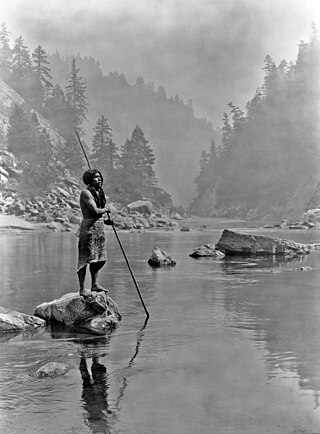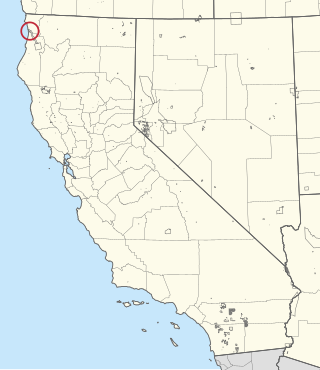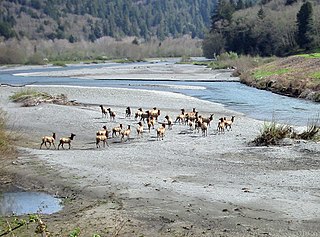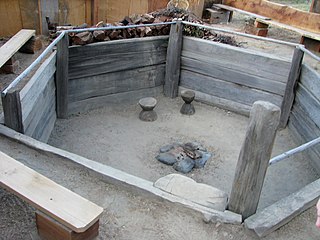
Hupa are a Native American people of the Athabaskan-speaking ethnolinguistic group in northwestern California. Their endonym is Natinixwe, also spelled Natinook-wa, meaning "People of the Place Where the Trails Return". The Karuk name was Kishákeevar / Kishakeevra. The majority of the tribe is enrolled in the federally recognized Hoopa Valley Tribe.
Chilula were a Pacific Coast Athabaskan tribe speaking a dialect similar to the Hupa to the east and Whilkut to the south, who inhabited the area on or near Lower Redwood Creek, in Northern California, some 500 to 600 years before contact with Europeans.

Hupa is an Athabaskan language spoken along the lower course of the Trinity River in Northwestern California by the Hoopa Valley Hupa and Tsnungwe/South Fork Hupa and, before European contact, by the Chilula and Whilkut peoples, to the west.

The Resighini Rancheria, located just south of Klamath, California, is a federally recognized tribe of Yurok people.

The Chimariko are an indigenous people of California, who originally lived in a narrow, 20-mile section of canyon on the Trinity River in Trinity County in northwestern California.

Chimariko is an extinct language isolate formerly spoken in northern Trinity County, California, by the inhabitants of several independent communities. While the total area claimed by these communities was remarkably small, Golla (2011:87–89) believes there is evidence that three local dialects were recognized: Trinity River Chimariko, spoken along the Trinity River from the mouth of South Fork at Salyer as far upstream as Big Bar, with a principal village at Burnt Ranch; South Fork Chimariko, spoken around the junction of South Fork and Hayfork Creek, with a principal village at Hyampom; and New River Chimariko, spoken along New River on the southern slopes of the Trinity Alps, with a principal village at Denny.

The Whilkut also known as "(Upper) Redwood Creek Indians" or "Mad River Indians" were a Pacific Coast Athabaskan tribe speaking a dialect similar to the Hupa to the northeast and Chilula to the north, who inhabited the area on or near the Upper Redwood Creek and along the Mad River except near its mouth, up to Iaqua Butte, and some settlement in Grouse Creek in the Trinity River drainage in Northwestern California, before contact with Europeans.
Hupa traditional narratives include myths, legends, tales, and oral histories preserved by the Hupa, Chilula, and Whilkut people of the Trinity River basin and vicinity of northwestern California. The Hupa people of modern times number in the several thousands and live in the Hoopa Valley located in Humboldt County, California.
Wiyot traditional narratives include myths, legends, tales, and oral histories preserved by the Wiyot people of the Humboldt Bay area of northwestern California.
Hoopa is an unincorporated community and census-designated place (CDP) in Humboldt County, California. It is located 10 miles (16 km) south of Weitchpec, at an elevation of 328 feet (100 m). The ZIP Code is 95546.

Burnt Ranch is a census-designated place (CDP) in Trinity County, California. It has a school and a post office. Its ZIP Code is 95527, and it is in area code 530. Its elevation is 1,502 feet (458 m). Its population is 250 as of the 2020 census, down from 281 from the 2010 census.
Pliny Earle Goddard was an American linguist and ethnologist noted for his extensive documentation of the languages and cultures of the Athabaskan peoples of western North America. His early research, carried out under the auspices of the University of California, Berkeley, focused on the Hupa and adjacent Athabaskan groups in northwestern California. After moving to New York in 1909 at the invitation of Franz Boas his scope expanded to include the Athabaskans of the Southwest, Canada, and Alaska. During the 1910s and 1920s. as Boas's junior colleague at the American Museum of Natural History and Columbia University, Goddard played a major role in creating the academic infrastructure for American Indian linguistics and anthropology in North America.

Mattole, or Mattole–Bear River, is an extinct Athabaskan language once spoken by the Mattole and Bear River peoples of northern California. It is one of the four languages belonging to the California Athabaskan cluster of the Pacific Coast Athabaskan languages. It was found in two locations: in the valley of the Mattole River, immediately south of Cape Mendocino on the coast of northwest California, and a distinct dialect on Bear River, about 10 miles to the north.
Fort Gaston was founded on December 4, 1859, in the redwood forests of the Hoopa Valley, in Northern California, on the west bank of the Trinity River, 14 miles (23 km) from where the Trinity flows into the Klamath River. It was located in what is now the Hoopa Valley Indian Reservation. Fort Gaston as part of the Humboldt Military District was intended to control the Hupa Indians and to protect them from hostile white settlers. The post was named for 2nd Lieutenant William Gaston, of the First Dragoons, who had been killed May 17, 1858, during the Spokane–Coeur d'Alene–Paloos War.

The Tsnungwe or Tsanunghwa are a Native American people indigenous to the modern areas of the lower South Fork Trinity River, Willow Creek, Salyer, Burnt Ranch and New River along the Trinity River in Trinity and Humboldt County in California. The Tsnungwe were a bilingual Hupa-Chimariko-speaking people and are known by the Hupa-speaking peoples as tse:ning-xwe. The primary language was the Tsnungwe dialect of Hupa, and the secondary language was Chimariko, although spoken with a Hupa accent.
Ribes marshallii is a North American species of currant known by the common names Hupa gooseberry and Marshall's gooseberry. It is endemic to the Klamath Mountains of southern Oregon and northern California.
Hupa are a Native American people in northwestern California.
Verdena Leona Parker is the last fluent speaker of the Hupa language, an Athabaskan language spoken by the Hoopa Valley Tribe, indigenous to northern California. While other children of her generation were sent to boarding schools, isolating them from their families, Parker was raised by her grandmother, who spoke Hupa with her. Through adulthood, Parker continued to speak Hupa with her mother daily, maintaining a high level of fluency despite language loss in the rest of the Hupa community.
Victor Golla (1939–2021) was a linguist and a leading expert on the indigenous languages of California and Oregon, especially the Pacific Coast Athabaskan subgroup of the Athabaskan language family and the languages of the region that belong to the Penutian phylum. He was emeritus professor of anthropology at Humboldt State University and lived in Trinidad, California.

A clapper stick is a traditional idiophone common among the indigenous peoples of California. It is traditionally constructed by cutting the branch of an elderberry tree, hollowing it out, and partially splitting the branch in two. It is used to keep time and accompany singers and dancers. Many are now made of bamboo, which do not require hollowing.








